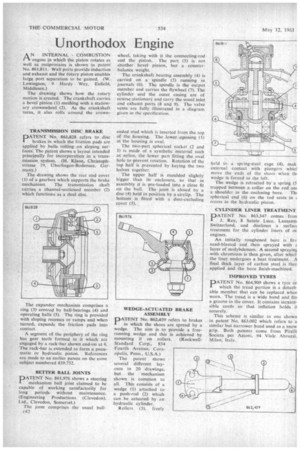TRANSMISSION DISC BRAKE P ATENT No. 861.828 refers to disc brakes
Page 78

If you've noticed an error in this article please click here to report it so we can fix it.
in which the friction pads are applied by balls rolling on sloping surfaces. The patent shows a layout intended principally for incorporation in a transmission system. (B. Matte, Christophstrasse 19, Uberlingen-Bodensee, Germany.)
The drawing shows the rear end cover (1) of a gearbox which supports the brake mechanism. The transmission shaft carries a channel-sectioned member (2} which functions as a dual disc.
The expander mechanism comprises a ring (3) centred by ball-bearings (4) and operating balls (5). The ring is provided with sloping recesses or ramps and when turned, expands the friction pads into contact.
A segment of the periphery of the ring has gear teeth formed in it which arc engaged by a rack-bar shown end-on at 6. The rack-bar is extended to form a pneumatic or hydraulic piston. References are made to an earlier patent on the same subject numbered 839,732.
BETTER BALL JOINTS
PATENT No. 861,976 shows a steering mechanism ball joint claimed to be capable of working satisfactorily for long periods without maintenance. (Engineering Productions (Cievedon). Ltd., Clevedon, Somerset.) The joint comprises the usual built-42
ended stud which is inserted from the top of the housing. The lower opening (I) in the housing is oval.
The two-part spherical socket (2 and 3) is made of a synthetic material such as nylon, the lower part fitting the oval hole to prevent rotation. Rotation of the top half is prevented by keying the two halves together.
The upper half is moulded slightly bigger than its enclosure, so that in assembly it is pre-loaded into a close fit on the ball, The joint is closed by a disc (4) held in position by a circlip. The bottom is fitted with a dust-excluding cover (5).
PATENT No. 862,439 refers to brakes in which the shoes are spread by a wedge. The aim is to provide a freerunning wedge and this is achieved by mounting it on rollers. (RockwellStandard Corp., 834 Fourth Avenue, Coraopolis, Penn., U.S.A.)
The patent shows several different layouts in 20 drawings, but the mechanism shown is common to all. This consists of a wedge (1) attached to a push-rod (2) which can be actuated by on hydraulic cylinder.
Rollers (3). freely held in a spring-steel cage (4), mak external contact with plungers whicl move the ends of the shoes when till wedge is forced to the left.
The wedge is retracted by a spring (5 trapped between a collar on the rod am a shoulder in the enclosing bore. Th4 spherical end (6) on the rod seats in t recess in the hydraulic piston.
CYLINDER LINER TREATMENT DATENT No. 863,347 comes fron J. Rey, 8 Sainte Luce, Lausanm Switzerland, and discloses • a . surfact treatment for the cylinder liners of oi engines.
An initially roughened bore is firsi sand-blasted and then sprayed with ti layer of molybdenum. A second spraying with chromium is then given, after whict the liner undergoes a heat treatment. A final thick layer of carbon steel is then applied and the bore finish-machined.
IMPROVED TYRES
PATENT No. 864,909 shows a tyre on which the tread portion is a detachable member that can be replaced when worn. The tread is a wide band and fits a groove in the cover. It contains inextensible cords so that inflation holds it securely.
This scheme is similar to one shown in patent No, 863,002 which refers to -a similar but narrower band used as a snow grip. Both patents come from Pirelli Societa per Azioni, 94 Viale Abruzzi. Milan, Italy.
























































































































